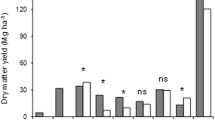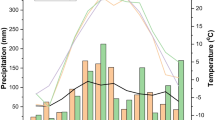Abstract
The agronomic performances of giant miscanthus (Miscanthus x giganteus) and switchgrass (Panicum virgatum L.) grown as bioenergy grasses are still unclear in North Carolina, due to a relatively short period of introduction. The objectives of the study were to compare the biomass yield and annual N removal of perennial bioenergy grasses and the commonly grown coastal bermudagrass [Cynodon dactylon (L.) Pers.], and to determine the optimum N rates and harvest practices for switchgrass and miscanthus. A 4-year field trial of the grasses under five annual harvest frequencies (May/Oct, June/Oct, July/Oct, Aug/Oct, and October only) and five annual N rates (0, 67,134, 202, and 268 kg N ha−1) was established at a research farm in Eastern North Carolina in 2011. Across harvest treatments and N rates, greatest biomass was achieved in the second growth year for both miscanthus (19.0 Mg ha−1) and switchgrass (15.9 Mg ha−1). Grasses demonstrated no N response until the second or the third year after crop establishment. Miscanthus reached a yield plateau with a N rate of 134 kg ha−1 since achieving plant maturity in 2013, whereas switchgrass demonstrated an increasing fertilizer N response from 134 kg N ha−1 in the third growth year (2014) to 268 kg N ha−1 in the fourth growth year (2015). The two-cut harvest system is not recommended for bioenergy biomass production in this region because it does not improve biomass yield and increased N removal leads to additional costs.



Similar content being viewed by others
References
Acaroglu M, Aksoy AS (2005) The cultivation and energy balance of Miscanthus x giganteus production in Turkey. Biomass Bioenergy 29:42–48
Anderson RL, Nelson LA (1987) Linear-plateau and plateau-linear-plateau models: usefulness in evaluating nutrient responses. Tech bull 283. North Carolina State Univ, Raleigh
Arundale RA, Dohleman FG, Thomas BV, Long SP (2013) Nitrogen fertilization does significantly increase yields of stands of Miscanthus × giganteus and Panicum virgatum in multiyear trials in Illinois. Bioenergy Res 7:408–416
Beale CV, Long SP (1997) Seasonal dynamics of nutrient accumulation and partitioning in the perennial C-4-grasses Miscanthus ×giganteus and Spartina cynosuroides. Biomass Bioenergy 12:419–428
Boehmel C, Lewandowski I, Claupein W (2008) Comparing annual and perennial energy cropping systems with different management intensities. Agric Syst 96:224–236
Cadoux S, Riche AB, Yates NE, Machet JM (2012) Nutrient requirements of Miscanthus x giganteus: conclusions from a review of published studies. Biomass Bioenergy 38:14–22
Christian DG, Poulton PR, Riche AB, Yates NE (1997) The recovery of 15N-labelled fertilizer applied to Miscanthus x giganteus. Biomass Bioenergy 12:21–24
Christian DG, Poulton PR, Riche AB, Yates NE, Todd AD (2006) The recovery over several seasons of 15N-labelled fertilizer applied to Miscanthus x giganteus ranging from 1 to 3 years old. Biomass Bioenergy 30:125–133
Christian DG, Riche AB, Yates NE (2008) Growth, yield and mineral content of Miscanthus x giganteus grown as a biofuel for 14 successive harvests. Ind Crop Prod 28:320–327
Clifton-Brown JC, Breuer J, Jones MB (2007) Carbon mitigation by the energy crop, miscanthus. Glob Change Biol 13:2296–2307
Clifton-Brown JC, Lewandowski I, Andersson B (2001) Performance of 15 miscanthus genotypes at five sites in Europe. Agron J 93:1013–1019
Cosentino SL, Patane C, Sanzone E, Copani V, Foti S (2007) Effects of soil water content and nitrogen supply on the productivity of Miscanthus x giganteus Greef et Deu in a Mediterranean environment. Ind Crop Prod 25:75–88
Fedenko JR, Erickson JE, Woodard KR et al (2013) Biomass production and composition of perennial grasses grown for bioenergy in a subtropical climate across Florida, USA. Bioenergy Res 6:1082–1093
Fike JH, Parrish DJ, Wolf DD et al (2006) Long-term yield potential of switchgrass-for-biofuel systems. Biomass Bioenergy 30:198–206
Guretzky JA, Biermacher JT, Cook BJ, Kering MK, Mosali J (2011) Switchgrass for forage and bioenergy: harvest and nitrogen rate effects on biomass yields and nutrient composition. Plant Soil 339:69–81
Haines SA, Gehl RJ, Havlin JL, Ranney TG (2014) Nitrogen and phosphorus fertilizer effects on establishment of giant miscanthus. BioEnergy Res 8:17–27
Hardy DH, Tucker MR, Stokes CE (2014) Crop fertilization based on North Carolina soil tests. North Carolina Department of Agriculture and Consumer Services, Agronomic Division. Circular no. 1, Raleigh. http://www.ncagr.gov/agronomi/pdffiles/obook.pdf . Accessed 5 July 2017
Heaton EA, Voigt TB, Long SP (2004) A quantitative review comparing the yields of two candidate C4 perennial biomass crops in relation to nitrogen, temperature and water. Biomass Bioenergy 27:21–30
Heaton E, Dohleman FG, Long SP (2008) Meeting US biofuel goals with less land: the potential of miscanthus. Glob Change Biol 14:2000–2014
Heaton EA, Dohleman FG, Long SP (2009) Seasonal nitrogen dynamics of Miscanthus × giganteus and Panicum virgatum. GCB Bioenergy 1:297–307
Himken M, Lammel J, Neukirchen D et al (1997) Cultivation of miscanthus under west European conditions: seasonal changes in dry matter production, nutrient uptake and remobilization. Plant Soil 189:117–126
Hong CO, Owens VN, Bransby D et al (2014) Switchgrass response to nitrogen fertilizer across diverse environments in the USA: a regional feedstock partnership report. Bioenergy Res 7:777–788
Israel DW, Smyth TJ (2015) Crop utilization of nitrogen in swine lagoon sludge. Commun Soil Sci Plant Anal 46:1525–1539
Kering MK, Butler TJ, Biermacher JT, Guretzky JA (2012) Biomass yield and nutrient removal rates of perennial grasses under nitrogen fertilization. Bioenergy Res 5:61–70
Kering MK, Butler TJ, Biermacher JT et al (2013) Effect of potassium and nitrogen fertilizer on switchgrass productivity and nutrient removal rates under two harvest systems on a low potassium soil. Bioenergy Res 6:329–335
Knoll JE, Anderson WF, Strickland TC et al (2012) Low-input production of biomass from perennial grasses in the Coastal Plain of Georgia, USA. Bioenergy Res 5:206–214
Larsen SU, Jorgensen U, Kjeldsen JB, Lærke PE (2014) Long-term miscanthus yield influenced by location, genotype, row distance, fertilization and harvest season. Bioenergy Res 7:620–635
Lewandowsk I, Heinz A (2003) Delayed harvest of Miscanthus—influences on biomass quantity and quality and environmental impacts of energy production. Eur J Agron 19:45–63
Lewandowski I, Schmidt U (2006) Nitrogen, energy and land use efficiencies of miscanthus, reed canary grass and triticale as determined by the boundary line approach. Agric Ecosyst Environ 112:335–346
Liu XJA, Fike JH, Galbraith JM, Fike WB (2015) Biosolids amendment and harvest frequency affect nitrogen use dynamics of switchgrass grown for biofuel production. Bioenergy Res 8:560–569
McGinnis M, Stokes C, Cleveland B (2014) NCDA&CS plant tissue analysis guide. Plant/Waste/Solution/Media Analysis Section. North Carolina Department of Agriculture and Consumer Services, Agronomic Division, Raleigh
Mehlich A (1976) New buffer pH method for rapid estimation of exchangeable acidity and lime requirement of soils. Commun Soil Sci Plant Anal 7:637–652
Mehlich A (1984) Mehlich 3 soil test extractant: a modification of Mehlich 2 extractant. Commun Soil Sci Plant Anal 15:1409–1416
Miguez FE, Villamil MB, Long SP, Bollero GA (2008) Meta-analysis of the effects of management factors on Miscanthus x giganteus growth and biomass production. Agric For Meteorol 148:1280–1292
Monti A, Bezzi G, Pritoni G, Venturi G (2008) Long-term productivity of lowland and upland switchgrass cytotypes as affected by cutting frequency. Bioresour Technol 99:7425–7432
Owens VN, Viands DR, Mayton HS et al (2013) Nitrogen use in switchgrass grown for bioenergy across the USA. Biomass Bioenergy 58:286–293
Palmer IE, Gehl RJ, Ranney TG, Touchell D, George N (2014) Biomass yield, nitrogen response, and nutrient uptake of perennial bioenergy grasses in North Carolina. Biomass Bioenergy 63:218–228
Pedroso GM, Hutmacher RB, Putnama D et al (2013) Yield and nitrogen management of irrigated switchgrass systems in diverse ecoregions. Agron J 105:311–320
Perrish AS (2013) Yield response to nitrogen fertilization and harvest timing on a mature Miscanthus x giganteus stand. Dissertation, University of Illinois at Urbana-Champaign, Urbana, Illinois
Reynolds J, Walker C, Kirchner M (2000) Nitrogen removal in switchgrass biomass under two harvest systems. Biomass Bioenergy 19:281–286
Sanderson MA, Read JC, Reed RL (1999) Harvest management of switchgrass for biomass feedstock and forage production. Agron J 91:5–10
SAS Institute (2011) SAS/STAT User's Guide. Version 9.3. SAS Inst, Cary
Schwarz H, Liebhard P, Ehrendorfer K, Ruckenbauer P (1994) The effect of fertilization on yield and quality of Miscanthus sinensis ‘Giganteus’. Ind Crop Prod 2:153–159
Staley TE, Stout WL, Jung GA (1991) Nitrogen use by tall fescue and switchgrass on acidic soils of varying water holding capacity. Agron J 83:732–738
Strullu L, Cadoux S, Preudhomme M et al (2011) Biomass production and nitrogen accumulation and remobilisation by Miscanthus×giganteus as influenced by nitrogen stocks in belowground organs. Field Crop Res 121:381–391
Stout WL, Jung GA (1995) Biomass and nitrogen accumulation in switchgrass: effects of soil and environment. Agron J 876:63–669
Thomason WE, Raun WR, Johnson GV, Taliaferro CM, Freeman KW, Wynn KJ, Mullen RW (2004) Switchgrass response to harvest frequency and time and rate of applied nitrogen. J Plant Nutr 27:1199–1226
Wullschleger SD, Davis EB, Borsuk ME, Gunderson CA, Lynd LR (2010) Biomass production in switchgrass across the United States: database description and determinants of yield. Agron J 102:1158–1168
Zub HW, Arnoult S, Brancourt-Hulmel M (2011) Key traits for biomass production identified in different miscanthus species at two harvest dates. Biomass Bioenergy 35:637–651
Author information
Authors and Affiliations
Corresponding author
Rights and permissions
About this article
Cite this article
Wang, Z., Jot Smyth, T., Crozier, C.R. et al. Yield and Nitrogen Removal of Bioenergy Grasses as Influenced by Nitrogen Rate and Harvest Management in the Coastal Plain Region of North Carolina. Bioenerg. Res. 11, 44–53 (2018). https://doi.org/10.1007/s12155-017-9876-x
Published:
Issue Date:
DOI: https://doi.org/10.1007/s12155-017-9876-x




